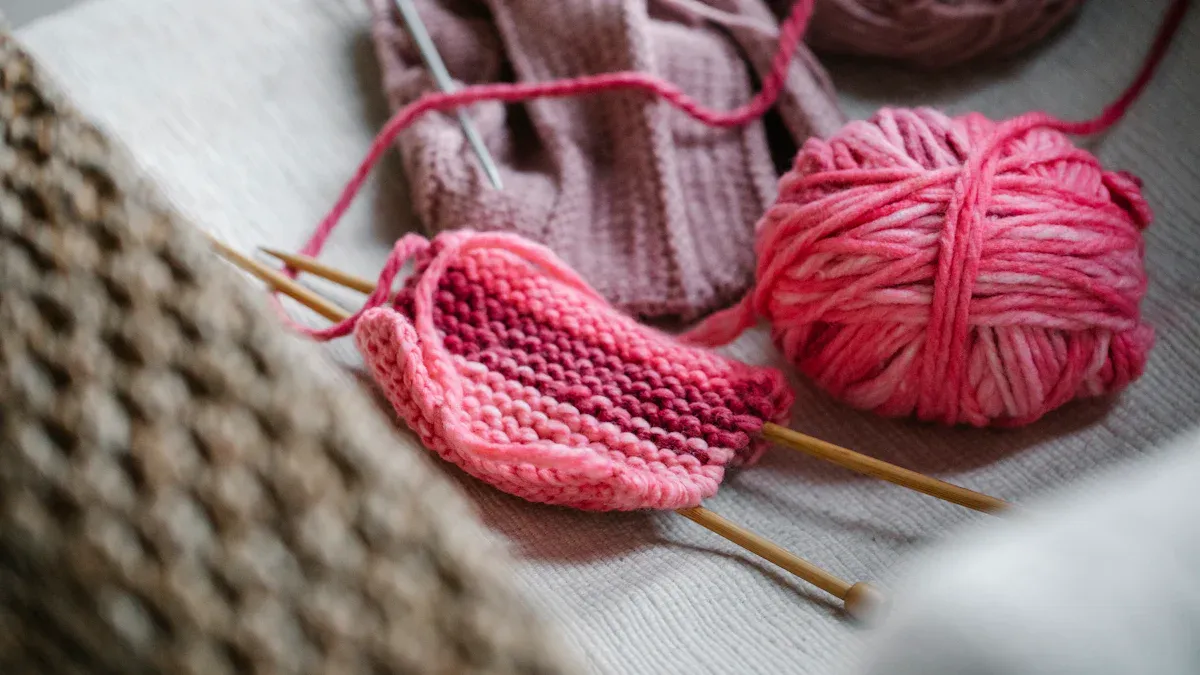
Curious about Knitting vs. Crochet? If you want something simple to start, crochet usually wins for beginners. You only need one hook, so it feels less tricky. Knitting uses two needles and works better for soft sweaters or drapey scarves. You might find crochet easier to pick up, but both crafts let you create amazing things. Try what feels right, and enjoy the process!
Key Takeaways
Crochet is easier to learn and faster to work with because it uses one hook and one loop at a time.
Knitting uses two needles and creates soft, stretchy fabric ideal for sweaters and scarves.
Crochet makes thicker, sturdy pieces perfect for blankets, hats, and home decor.
Starting crochet costs less since you only need one hook, while knitting requires two needles.
Choose the craft that fits your project goals, budget, and comfort to enjoy your crafting journey.
Knitting vs. Crochet: Quick Comparison
When you start a new hobby, it helps to see the basics side by side. Here’s a quick look at how knitting and crochet stack up for beginners.
Feature | Knitting | Crochet |
|---|---|---|
Main Tool | Two needles | One hook |
Learning Curve | Takes more practice | Easier to pick up |
Fabric Texture | Smooth, stretchy, drapey | Dense, textured, sturdy |
Best Projects | Sweaters, socks, scarves | Blankets, toys, hats, coasters |
Cost to Start | Slightly higher (needles, yarn) | Lower (one hook, yarn) |
Speed | Slower for most beginners | Usually faster |
Fixing Mistakes | Can be tricky | Simple to undo and fix |
Tip: If you want to make a soft, flowing scarf or sweater, knitting works best. If you want to whip up a quick hat or a cute toy, crochet might be your new favorite.
Tools and Materials
You only need a few things to get started with either craft. For knitting, you use two needles. These can feel awkward at first, but you get used to them. Crochet uses just one hook. Many beginners find this easier to hold and control. Both crafts use yarn, but you might notice that crochet hooks cost less than a pair of knitting needles. You can also find starter kits for both crafts at most craft stores.
Learning Curve
Let’s talk about how fast you can learn. Crochet usually feels simpler for beginners. You only have to manage one loop at a time. If you drop a stitch, you can fix it quickly. Knitting takes a bit more patience. You have to keep several stitches on your needles. If you drop one, it can unravel down your work. Don’t worry, though—lots of people learn both! You just need a little practice.
Project Types
Think about what you want to make. Knitting vs. Crochet comes down to your project goals. Knitting makes soft, stretchy fabric. You’ll love it for sweaters, socks, and anything that needs to drape. Crochet creates thicker, more textured pieces. It’s perfect for blankets, hats, bags, and even stuffed animals. You can make almost anything with either craft, but some projects work better with one or the other.
Cost and Speed
Starting a new hobby shouldn’t break the bank. Crochet usually costs less at first. You only need one hook, and you can find affordable yarn. Knitting needs two needles, so the price goes up a bit. When it comes to speed, crochet often wins. You can finish a scarf or a hat in less time. Knitting takes longer, especially when you’re just starting out. But the results can be worth it!
Remember, there’s no right or wrong answer in the Knitting vs. Crochet debate. Try both if you can. You might surprise yourself with what you enjoy most!
Tools for Beginners
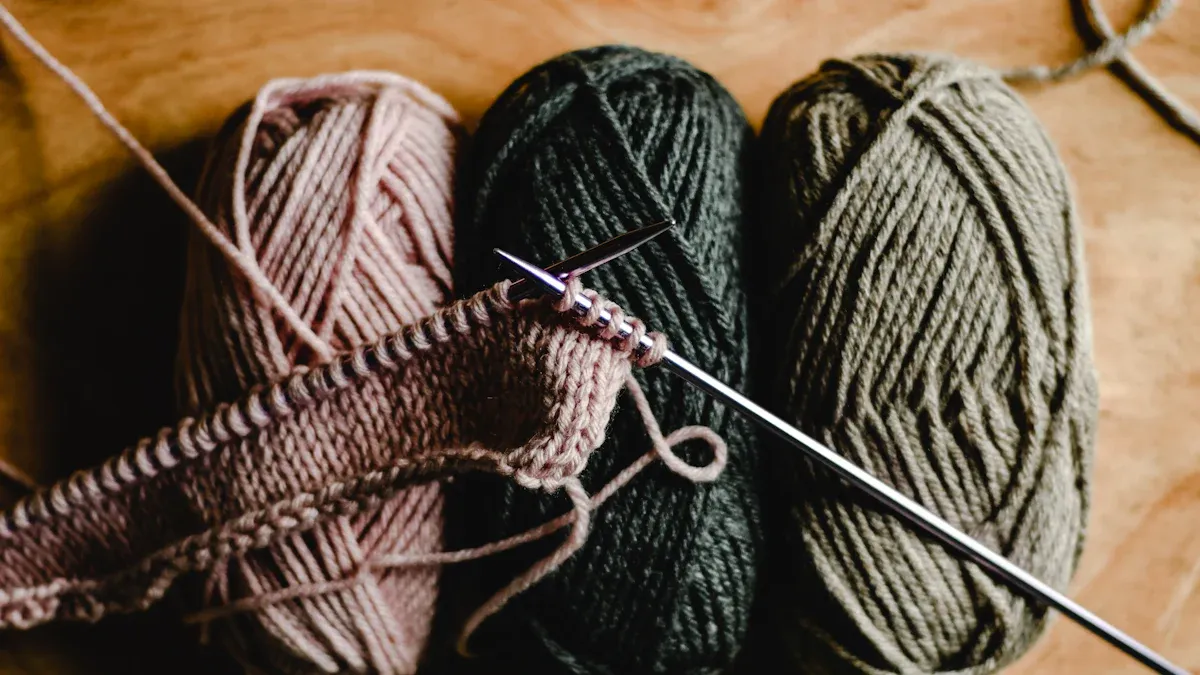
Knitting Needles
When you start knitting, you need the right needles. Most beginners like bamboo or plastic needles. These feel light in your hands and help keep stitches from slipping off. Bamboo needles are especially popular because they have a grippy surface and cost less than metal ones. Plastic needles are also cheap and easy to find. You can try straight needles for simple projects, but circular or interchangeable sets give you more options as you learn. Many starter kits, like those from Knit Picks, offer several sizes and cables in one box. These kits help you try different projects without buying lots of separate needles. Most beginners find these sets easy to use and affordable, though you may need to tighten the cables sometimes.
Tip: Avoid very cheap needles from big box stores. They can bend or break and make learning harder.
A helpful guide from Interweave says that having the right tools makes knitting more fun and helps your projects fit better. Good tools can turn a tricky project into a rewarding one.
Crochet Hooks
Crochet hooks keep things simple. You only need one hook to get started. Most beginners pick a medium size, like 5mm or H-8, because it works well with many yarns. Hooks come in plastic, aluminum, or bamboo. Plastic hooks are light and cheap, while bamboo hooks feel smooth and comfy. You can find a hook and yarn for under $10, so crochet is easy on your wallet. Many people say crochet feels less confusing than knitting because you only manage one loop at a time. This makes it great for quick projects and learning on the go.
Hooks are easy to hold and carry.
Mistakes are simple to fix—just pull out the stitches and try again.
Yarn and Accessories
Yarn choice matters for beginners. Most people start with medium-weight acrylic or cotton yarn. Acrylic yarn is warm, strong, and comes in many colors. Cotton yarn feels soft and is gentle on your skin. If you have sensitive skin, cotton is a great pick. Accessories like scissors, a yarn needle, and stitch markers help you finish your projects neatly.
Yarn Type | User Preference (%) | Key Properties | Impact on Beginner Project Success |
|---|---|---|---|
Cotton | Soft, absorbent, skin-friendly | Great for comfort and summer projects | |
Acrylic | 40% | Warm, durable, colorful | Good for winter and sturdy items |
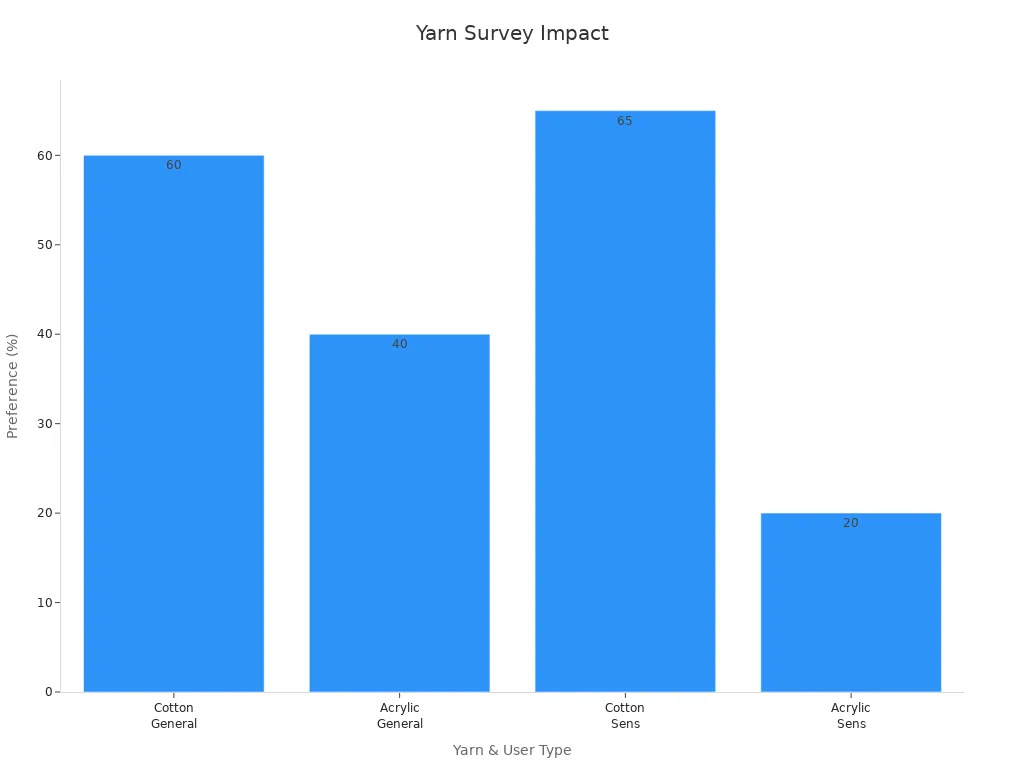
Note: Picking the right yarn helps your first projects look and feel better. Try a few types to see what you like best.
Basic Techniques
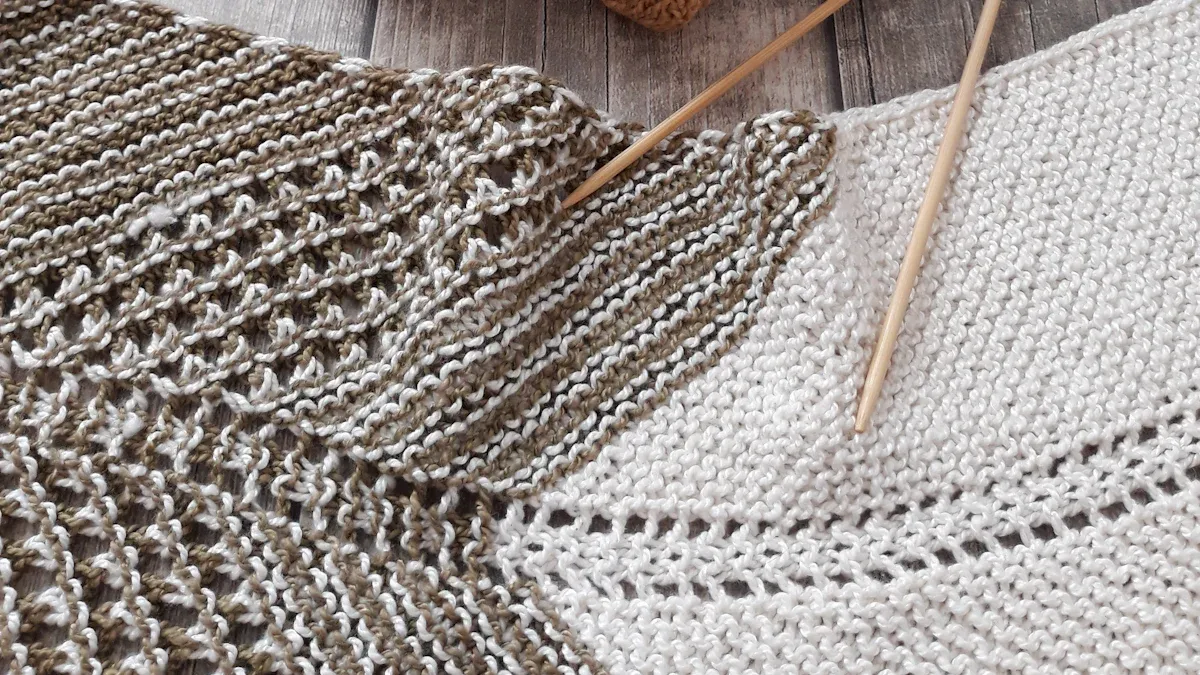
Knitting Stitches
When you start knitting, you learn two main stitches: the knit stitch and the purl stitch. These two moves let you create many patterns. For example, if you knit every row, you get a bumpy fabric called garter stitch. If you knit one row and purl the next, you make stockinette stitch, which looks smooth on one side and bumpy on the other. Ribbing uses both knit and purl stitches in the same row. This makes stretchy edges for hats or cuffs.
Knit stitch: Makes a flat, smooth surface.
Purl stitch: Adds bumps and texture.
Garter stitch: Knit every row for a squishy, stretchy fabric.
Stockinette stitch: Alternate knit and purl rows for a classic look.
Ribbing: Mix knit and purl stitches in the same row for stretchy bands.
You need to count your stitches and rows to keep your project neat. Many beginners use stitch markers or row counters to help. You can also count rows by looking at the pattern of bumps and lines in your work. Learning to read patterns and understand symbols helps you follow instructions and finish projects that look just right. Studies show that different stitch patterns change how stretchy or stiff your fabric feels. For example, ribbing is softer and stretchier than garter stitch.
Crochet Stitches
Crochet starts with a chain. You make a row of loops, then build on top of them. The most common stitches are single crochet and double crochet. Single crochet makes a tight, firm fabric. Double crochet is taller and works up faster, so your project grows quickly.
Chain stitch: The base for every crochet project.
Single crochet: Short, tight, and sturdy.
Double crochet: Taller, looser, and faster to make.
Slip stitch: Joins pieces or moves your yarn without adding height.
You only have one active loop at a time, so you can focus on each stitch. This makes crochet easy to learn and less stressful if you make a mistake.
Fixing Mistakes
Everyone makes mistakes when learning. In knitting, you might drop a stitch. This can cause a hole or make your work unravel. Fixing it takes practice, but you can use a crochet hook or needle to pick up the stitch. Using stitch markers and counting rows helps you catch mistakes early.
In crochet, fixing mistakes is simple. You just pull out the stitches until you reach the problem, then start again. Since you only have one live loop, you don’t have to worry about losing lots of stitches at once.
Don’t stress about mistakes! Every project teaches you something new. With practice, you’ll get better at spotting and fixing errors.
Knitting vs. Crochet: Project Suitability
Choosing between knitting and crochet often depends on what you want to make. Some projects work better with one craft than the other. Let’s look at the most popular beginner projects and see which method fits best.
Best for Garments
If you dream of making sweaters, cardigans, or soft tops, knitting usually gives you the best results. Knitted fabric feels smooth and drapes nicely. This makes it perfect for clothes that need to hang softly or stretch, like sweaters and shawls. You can also knit socks and lightweight tops that feel comfy against your skin.
Crochet creates a thicker, more textured fabric. You can make garments with crochet, but they often feel heavier and less stretchy. Crochet shines for summer tops, vests, or openwork cardigans where you want a bit of structure or a lacy look.
Here’s a quick look at how different yarns work for garments in both crafts:
Yarn Type | Best For (Knitting) | Best For (Crochet) | Beginner Tips |
|---|---|---|---|
Cotton | Summer sweaters, light tops | Lacy tops, summer vests | Feels soft, easy to grip, gentle care |
Acrylic | Warm sweaters, scarves | Cozy cardigans, winter hats | Durable, easy to wash, holds shape |
Blended Yarns | All-season wear, baby items | Afghans, baby costumes | Soft, stretchy, easy to handle |
Most knitters and crocheters pick cotton for comfort in summer and acrylic for warmth in winter. Blended yarns give you the best of both worlds.
Best for Accessories
Accessories are a great way to start your crafting journey. Both knitting and crochet let you make scarves, hats, and mittens. Knitting works well for stretchy hats, soft scarves, and fingerless gloves. The fabric feels smooth and fits snugly.
Crochet is perfect for quick hats, chunky scarves, and textured headbands. You can finish a crochet hat in just a few hours. Crochet also makes it easy to add fun details, like flowers or pom-poms.
Here are some beginner-friendly accessory ideas:
Knitting: Scarves, beanies, mittens, socks, headbands
Crochet: Hats, cowls, ear warmers, scrunchies, bags
Want to finish a project fast? Try a crochet hat or headband. If you want a classic, stretchy scarf, knitting is your friend.
Best for Home Decor
Home decor projects let you add a handmade touch to your space. Crochet stands out for sturdy, structured items like blankets, coasters, baskets, and even rugs. The thicker fabric holds its shape and works up quickly. You can make colorful granny square blankets or cute amigurumi toys for your room.
Knitting creates softer, drapier blankets and throws. If you want a cozy, lightweight blanket or a pillow cover that feels smooth, knitting is a great choice. Knitted dishcloths and table runners also look elegant.
Here’s a quick list of popular home decor projects:
Knitting: Blankets, pillow covers, dishcloths, table runners
Crochet: Blankets, baskets, coasters, plant hangers, toys
If you want a sturdy basket or a thick rug, crochet is the way to go. For a soft, drapey throw, knitting works best.
When you think about Knitting vs. Crochet, remember that each craft has its strengths. Knitting gives you soft, stretchy fabric for garments and accessories. Crochet lets you build sturdy, textured pieces for home decor and quick gifts. Try both crafts to see which one matches your style and project goals.
Other Considerations
Yarn Usage
You might wonder how much yarn you’ll need for your first project. Knitting usually uses less yarn than crochet. The stitches in knitting are flatter and closer together, so your project feels lighter and stretches more. Crochet stitches are taller and thicker, which means you’ll use more yarn for the same size project. If you want to save yarn or work with a limited supply, knitting could be a better choice. On the other hand, crochet’s thicker fabric can make your projects feel extra cozy and sturdy.
Tip: If you want to make a big blanket or sweater, plan for extra yarn if you choose crochet.
Time Investment
Time matters when you start a new hobby. Crochet often works up faster than knitting. The stitches are bigger, so your project grows quickly. Many beginners finish their first crochet scarf or hat in just a few days. Knitting takes a bit longer, especially if you’re learning to keep your stitches even. Some people find the slower pace of knitting relaxing, while others love the quick results from crochet. Think about how much time you want to spend and how fast you want to see progress.
Here’s a quick look at project speed:
Project Type | Crochet (Time) | Knitting (Time) |
|---|---|---|
Scarf | 1-2 days | 2-4 days |
Hat | 1 day | 2-3 days |
Blanket | 1-2 weeks | 2-4 weeks |
Physical Comfort
Comfort is important, especially if you plan to craft for hours. Crochet feels gentle on your hands because you use one hook and a looser grip. Many people with arthritis or hand pain prefer crochet, especially when using ergonomic hooks with soft handles. Surveys show that over 78% of people with arthritis feel less pain when they use these special hooks. Adjustable grips and neutral wrist positions help reduce joint stress.
Knitting uses two needles and a different motion. Some people find this soothing and enjoy how it spreads the work between both hands. Experts say that knitters sometimes use too much force, which can lead to aches or numbness. You can find ergonomic knitting needles and crochet hooks to help reduce strain. Try both crafts and see which one feels best for you.
Everyone’s hands are different. Listen to your body and take breaks to stay comfortable.
How to Choose
Decision Checklist
Not sure where to start? Use this simple checklist to help you decide which craft fits you best:
List your project ideas. Do you want to make clothes, blankets, or toys?
Think about your budget. Would you rather buy one hook or a set of needles?
Rate how much you value speed. Do you want quick results or enjoy a slower pace?
Decide how important fixing mistakes is for you. Do you want an easy way to undo errors?
Pick the fabric feel you like. Do you want soft and stretchy or thick and sturdy?
Give each factor a score from 1 (not important) to 5 (very important).
Add up your scores for each craft. The higher score shows which one matches your needs.
Tip: There’s no wrong answer. Your choice should fit your goals and what makes you excited to create.
Learning Style
Everyone learns in their own way. Some people like to see each step, while others want to use their hands right away. Check out this table to see which craft might suit your learning style:
Aspect | Crocheting | Knitting |
|---|---|---|
Ease of Learning | Great for visual learners; easy to see each stitch | Good for hands-on learners; uses two needles |
Learning Style | Visual learning works well | Hands-on learning works well |
Resources | Many tutorials, classes, and books | Many tutorials, classes, and books |
If you like to watch and follow along, crochet might feel easier. If you want to use both hands and try new moves, knitting could be your pick.
Try Both
Gather Basic Supplies (Minimal Investment):
For Crochet: You’ll need just one crochet hook (a medium size like 5.0 mm or H is a good start) and a skein of worsted-weight yarn in a light color (so you can see your stitches easily).
For Knitting: You’ll need a pair of knitting needles (again, a medium size like 5.0 mm or US size 8) and another skein of worsted-weight yarn. Choose an inexpensive, acrylic yarn for both to keep costs low while you experiment.
Learn the Fundamentals (Small Bites):
Start with Crochet: Focus on mastering the slip knot, chain stitch (ch), and single crochet (sc). These three stitches are the building blocks for countless crochet projects.
Then Try Knitting: Learn how to make a slip knot, cast on (getting stitches onto your needle), and the knit stitch (k). The knit stitch alone can create simple, satisfying fabric.
Practice with Small Swatches (No Pressure!):
Instead of jumping into a big project, create small squares (often called swatches) of fabric using the basic stitches for each craft. This helps you get a feel for the tools and the tension. Don’t worry about perfection; focus on the process.
Explore Simple Beginner Projects:
Crochet: A simple dishcloth or a basic coaster are excellent first projects that can be completed quickly, giving you a sense of accomplishment.
Knitting: A garter stitch scarf (made entirely of knit stitches) or a simple washcloth are perfect for beginners and build confidence.
Reflect and Compare:
As you try both, pay attention to how each feels in your hands. Do you prefer the single hook of crochet or the two needles of knitting? Do you like the speed of crochet or the rhythm of knitting? There’s no right or wrong answer—just what feels best to you.
The Science Behind Crafting and Well-being
Your intuition that making things with your hands is beneficial is strongly supported by research. Engagement in handicrafts like knitting and crochet offers significant psychological benefits:
Stress Reduction and Mindfulness: The repetitive motions involved in both crafts can act as a form of meditation, promoting a state of mindfulness. This focus on the present moment helps to quiet a busy mind, reduce rumination, and lower cortisol levels, the body’s primary stress hormone. Studies published in journals like the British Journal of Occupational Therapy have highlighted the therapeutic effects of crafting, showing significant reductions in anxiety and depression.
Boosts Happiness and Self-Esteem: Completing a project, no matter how small, triggers the release of dopamine, a neurotransmitter associated with pleasure and reward. This sense of accomplishment boosts self-esteem and provides a tangible representation of your skills and dedication.
Enhances Cognitive Function: Crafting engages various cognitive functions, including problem-solving (e.g., correcting mistakes), pattern recognition, and fine motor skills. This mental engagement can help maintain cognitive flexibility and may even reduce the risk of cognitive decline.
Fosters Connection and Community: Joining knitting or crochet groups, whether in person or online, creates opportunities for social interaction and connection. Sharing knowledge, asking for help, and showcasing your work builds a sense of belonging and reduces feelings of isolation.
A Crafter’s Journey: My Experience with Both
As someone who has embraced both knitting and crochet, I can personally attest to the unique joys each offers. I started with knitting, drawn to the smooth drape of the fabric and the satisfaction of seeing rows grow. My first project was a lopsided scarf, but the pride I felt was immense. Later, I picked up a crochet hook out of curiosity, intrigued by the different textures and structures I saw others creating. I quickly discovered that crochet allowed for more sculptural pieces and was incredibly fast for certain projects, like blankets.
What I’ve found is that neither craft is “better”—they are simply different tools for different creative expressions. I often switch between them depending on the project I have in mind, the yarn I’m using, or even just my mood. Sometimes, I crave the rhythmic click of knitting needles; other times, I enjoy the direct manipulation of the hook. This flexibility has enriched my crafting journey immensely.
You’ve seen how Knitting vs. Crochet each offer something special for beginners. Think about what you want to make and how you like to learn. Maybe you want quick results or love the look of soft, drapey fabric. Try the craft that excites you most. Both are fun, relaxing, and easy to start. You can always switch or try both later. Happy crafting! 🧶
FAQ
Can I use the same yarn for both knitting and crochet?
Yes, you can use most yarns for both crafts. Just check the yarn label for recommended hook or needle sizes. Thicker yarns work up faster and are easier for beginners.
Which is easier to learn: knitting or crochet?
Most people find crochet easier to start. You only use one hook and one active loop. Knitting takes more practice because you manage two needles and several stitches at once.
How do I fix a mistake if I mess up?
Don’t worry! In crochet, just pull out the stitches until you reach the error. In knitting, use a crochet hook or needle to pick up dropped stitches. Mistakes happen to everyone.
What projects should I try first?
Try a simple scarf, dishcloth, or headband.
Choose a small project so you can finish quickly.
Pick a pattern with clear instructions and photos.
Do I need special tools to get started?
No, you only need basic tools. For crochet, grab a hook, yarn, and scissors. For knitting, get two needles, yarn, and scissors. Stitch markers and a yarn needle help but are not required.



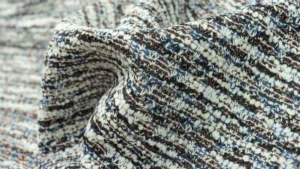
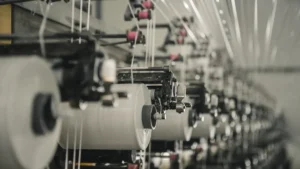
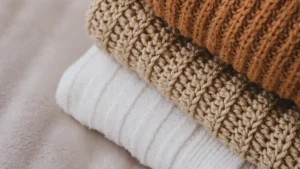


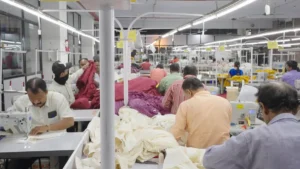

1 thought on “Knitting vs. Crochet for Beginners: Tools, Techniques & What to Choose First”
Pingback: Top Knitting Manufacturer Picks in Lyon for Every Need